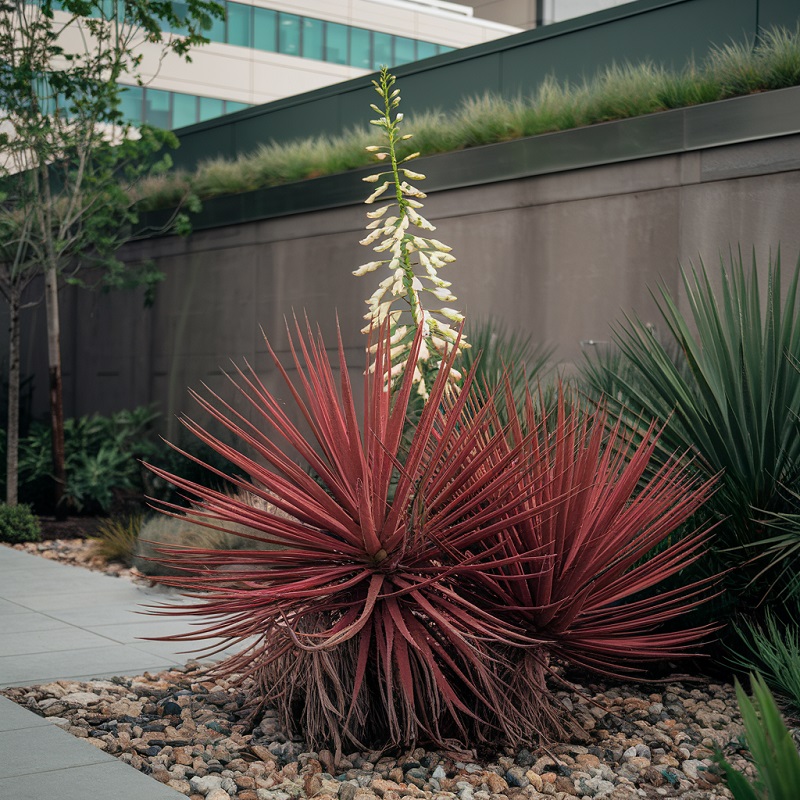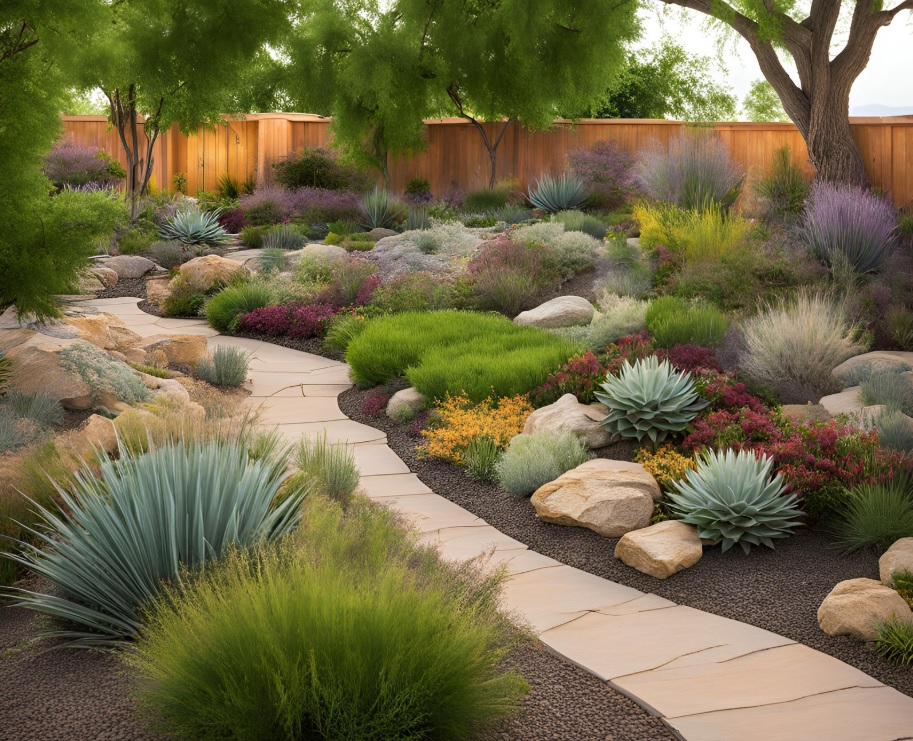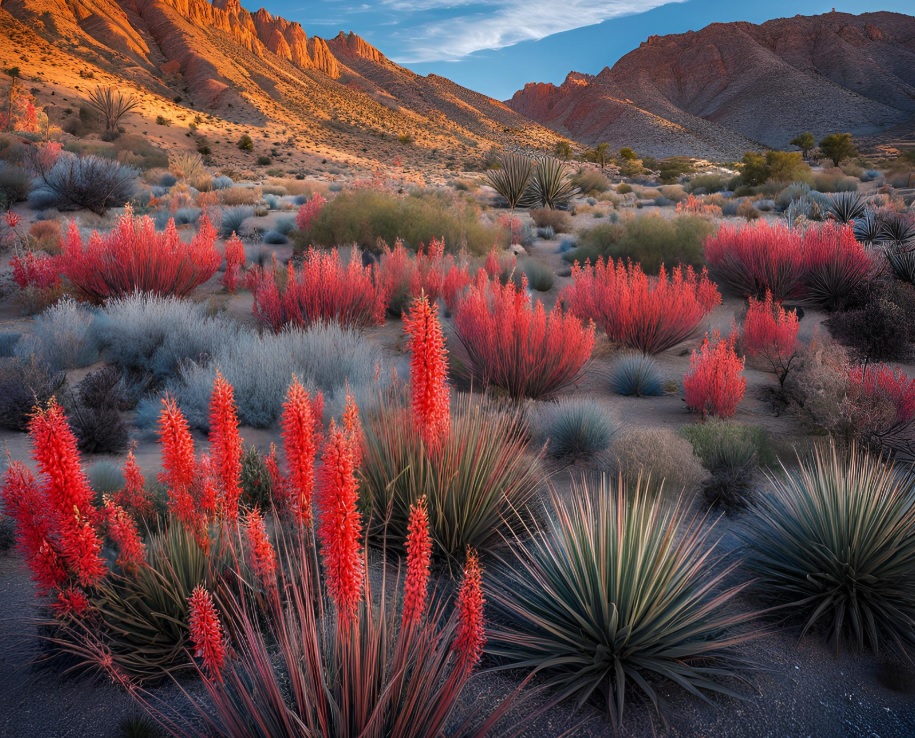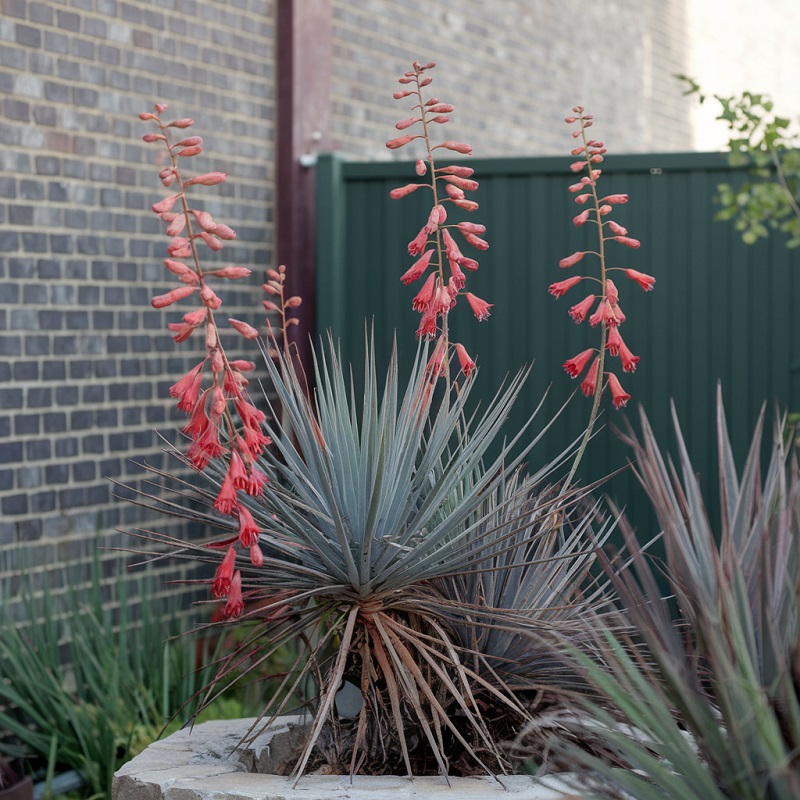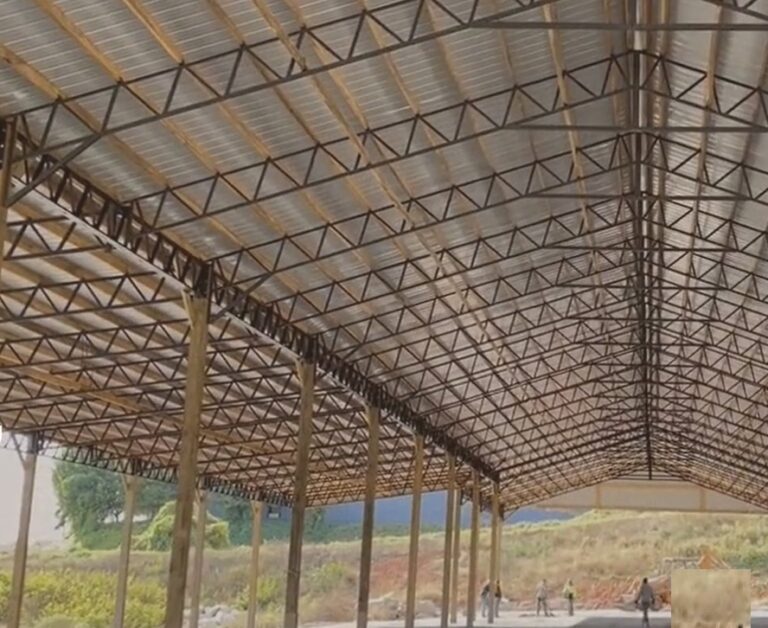When it comes to urban landscaping the Red Yucca is a tough, low maintenance superstar. With its looks, ability to survive tough conditions and eco friendly benefits this plant is taking over cities all over the US. But what makes the Red Yucca plant so cool and why is it a favorite in North Texas? Let’s get into it.
What is Red Yucca?
Red Yucca (Hesperaloe parviflora) is a perennial from Texas and northern Mexico. Not a true yucca but an agave. Long, slender leaves form a rosette and tall spikes of tubular, coral red flowers that attract hummingbirds.
Red Yucca plant Key Features:
- Hardy: Drought tolerant and pest and disease resistant.
- Height: 3-5 feet tall with flower spikes to 6 feet.
- Lifespan: Can live for decades with neglect.
- Climate Tolerance: Hot and dry, cold winters.
Red Yucca Origin and History
Red Yucca plant is native to the rocky hills of West Texas and northern Mexico. For centuries the indigenous people used the leaf fibers to make rope and baskets. Today it’s a staple in xeriscaping – an eco friendly landscaping method for water conservation.
Why Red Yucca is great for Urban Landscaping
Drought Tolerance
One of the biggest issues in urban landscaping is water management. The Red Yucca plant can survive in dry conditions and needs no irrigation once established. Perfect for cities looking to reduce water usage.
Low Maintenance
Red Yucca plant is a dream for those who want a beautiful landscape without the hassle. It needs no maintenance. No pruning, no fertilization, no pest control. City planners and homeowners love this.
Aesthetics
The red flowers of the Red Yucca plant bloom from spring to fall, adding a vibrant splash of color to urban spaces. Its unique shape makes it a captivating focal point in parks, medians, and residential gardens.
Eco Friendly Benefits
- Pollinators: Hummingbirds and bees love its tubular flowers.
- Erosion Control: Deep roots hold soil on slopes and in erosion prone areas.
- Air Quality: Like all plants it helps clean the air.
Where Is Red Yucca Most Popular?
Red Yucca loves North Texas where it’s drought tolerant and heatwave resistant. Urban areas like Dallas, Fort Worth and Austin use it in their public landscaping.
Examples:
- Dallas City Parks: Along walking trails and in community gardens.
- North Texas Medians: Used in medians to add greenery without watering.
- Austin Xeriscaping: A popular choice for residential landscaping.
Why Red Yucca plant in North Texas?
North Texas has hot summers and crazy weather. Red Yucca plant loves it and is a favorite for urban and residential landscapes. It’s resistant to drought and occasional freezes so it stays healthy all year round in this crazy climate.
How to Grow Red Yucca
Growing Conditions
- Sun: Full sun to partial shade.
- Soil: Well draining soil, rocky or sandy.
- Water: Minimal watering, overwatering can harm.
- Temp: Can tolerate extreme heat and cold to 0°F.
How to Grow
- Choose the Right Spot: Get full sun.
- Prepare the Soil: Add sand or gravel for drainage.
- Plant the Yucca: Space 2-3 feet apart.
- Water Light: Water only during first few weeks to establish roots.
Benefits of Using Red Yucca plant in Cities
Red Yucca plant vs. Traditional Grass Landscaping
| Feature | Red Yucca | Traditional Grass |
| Water Needs | Minimal | High |
| Maintenance | Low | Frequent mowing required |
| Aesthetic Appeal | High | Moderate |
| Pollinator Attraction | Yes | No |
Red Yucca pant as a Sustainable Option
In a world all about sustainability the Red Yucca plant stands out as an eco friendly option. With its water efficiency, durability and ecological benefits it’s the go to plant for eco conscious gardeners and urban planners. Here’s a closer look at why Red Yucca plant is the sustainable choice.
Drought Tolerance and Water Efficiency
One of the Red Yucca’s best features is its ability to survive in dry conditions. Native to the desert regions of Texas and northern Mexico this plant is naturally adapted to areas with little rainfall.
- Low Water Needs: Once established Red Yucca needs very little water, perfect for areas with water restrictions or ongoing droughts.
- Xeriscaping Hero: As a drought tolerant species it’s a key player in xeriscaping, a landscaping method that reduces or eliminates the need for supplemental irrigation.
- Water Savings: Studies show xeriscaped landscapes which include drought resistant plants like Red Yucca plant can reduce outdoor water use by 50-70%.
Soil Conservation and Erosion Control
Red Yucca’s deep roots not only hold the plant in place but also helps with soil conservation.
- Erosion Prevention: When planted on slopes or embankments Red Yucca plant holds the soil in place, reducing runoff during heavy rain.
- Soil Improvement: With minimal nutrient needs it doesn’t deplete the soil making it a sustainable option for poor or rocky soil.
Low Maintenance
Sustainability means reducing resource use and Red Yucca’s low maintenance fits into that principle.
- No Fertilizers Required: Red Yucca grows without chemical fertilizers, reducing the environmental impact of gardening.
- Pest Resistant: Unlike other ornamental plants Red Yucca plant is pest resistant, no pesticides needed and promotes healthier ecosystems.
- Self Cleaning: Its flower stalks and foliage need little pruning or maintenance, saving time, energy and resources.
Ecological Benefits
Red Yucca benefits local ecosystems in many ways.
- Wildlife Support: Its tubular flowers are a favorite of hummingbirds, butterflies and bees, helping to sustain pollinator populations.
- Native Adaptation: As a native plant Red Yucca plant fits in seamlessly with the local environment, requires less intervention than non native species.
Longevity and Resilience
Red Yucca’s lifespan and ability to withstand harsh conditions makes it a long term sustainable option for landscapes.
- Long Lived: One Red Yucca can live for decades, no need to replace.
Heat and Cold Tolerant: Tolerates extreme temperatures, desert heat and cold hardiness zones 6-11.
Urban Sustainability with Red Yucca
For urban planners, Red Yucca plant offers a sustainable solution for green spaces in cities.
- Reduced Urban Heat Island Effect: When used in medians, parking lots, or rooftop gardens, Red Yucca plant helps combat urban heat by providing greenery in concrete-dominated spaces.
- Low Impact on Infrastructure: Its non-invasive roots make it safe for planting near sidewalks and structures without causing damage.
The Red Yucca combines natural beauty with a host of sustainable benefits, making it an excellent choice for individuals, landscapers, and cities striving to create eco-friendly environments. By integrating this hardy plant into your landscape design, you’re not just enhancing its aesthetic appeal but also contributing to a more sustainable future.
Red Yucca plant Landscaping
Red Yucca plant is a versatile plant that can dress up any outdoor space with its beauty and low maintenance. It’s a favorite for both residential and commercial landscapes. Let’s see how to use Red Yucca in different landscapes and some practical tips to get the most out of its looks and function.
Red Yucca pant in Home Gardens
Red Yucca plant adds texture and elegance to residential landscapes. Here’s how you can use it at home:
- Xeriscaping: For drought tolerant gardens pair Red Yucca with gravel, rocks and other succulents like agave or sedum for a desert look.
- Borders and Edging: Plant Red Yucca along walkways, driveways or patios for a clean natural border that requires minimal maintenance.
- Accent Plant: Use Red Yucca plant as a focal point in your garden, place it in areas that need a splash of color and texture. Its tall flower stalks and weird foliage will grab attention naturally.
- Container Planting: For small spaces or patios plant Red Yucca in large, well draining containers. This gives you flexibility in placement and adds greenery to urban areas.
Red Yucca in Commercial Landscaping
Commercial spaces need greenery that looks good all year round and requires minimal maintenance. Red Yucca ticks all those boxes.
- Office Parks and Campuses: Use it in entrance gardens or along pathways for a professional yet lively atmosphere.
- Parking Lots and Medians: Its drought tolerance makes it perfect for areas exposed to heat and limited irrigation like parking lot islands or street medians.
- Shopping Centers: Red Yucca’s low profile and bright flowers add value without obstructing views in busy commercial areas.
Red Yucca in Public Spaces
For cities looking to make urban areas greener, Red Yucca offers many benefits that makes it perfect for public landscaping projects.
- Park Pathways: Line walking and biking paths with Red Yucca plant for a welcoming and visually pleasing look. Its flowers also attract hummingbirds for added charm in public parks.
- Erosion Control: Plant Red Yucca on slopes or embankments to prevent soil erosion. Its deep roots hold the ground while its foliage adds beauty.
- Urban Green Spaces: Incorporate Red Yucca into community gardens or pocket parks to introduce a low-maintenance yet eye-catching element.
Creative Ideas for Red Yucca
Here are some fun ways to use Red Yucca:
- Water Features: Surround fountains, ponds or dry riverbeds with Red Yucca for a desert look.
- Mixed Planting Beds: Combine Red Yucca with ornamental grasses, flowering perennials and shrubs for a layered look.
- Hummingbird Gardens: Plant Red Yucca near feeders or flowering plants that also attract pollinators for a wildlife garden.
- Seasonal Displays: Plant with annuals or perennials that bloom in different seasons for year round interest.
Spacing and Planting Tips for Red Yucca
- Spacing: Red Yucca grows into large clumps so leave 2-3 feet between each plant to allow them to spread.
- Planting Depth: Plant at the same depth as in the nursery container.
- Grouping: Plant in odd numbered groups (3s or 5s) for a more natural look.
- Companion Plants: Plant with low growing succulents like ice plants or contrast with taller cacti or agaves.
Benefits of Using Red Yucca in Landscaping
Feature Impact on Landscaping
Water Efficiency Reduces irrigation needs, conserving water.
Low Maintenance Saves time and resources for upkeep.
Seasonal Beauty Flowers bloom for months, adding year-round charm.
Wildlife Friendly Attracts hummingbirds and bees, boosting biodiversity.
Erosion Control Stabilizes soil on slopes and uneven terrains.
Don’t Do This
Some people mistakenly believe that the Red Yucca is invasive or difficult to grow. However, it’s neither! While it does spread through seeds, it’s easy to control and doesn’t overtake other plants.
To get the most out of Red Yucca in your landscape, don’t:
- Overwater: Red Yucca likes dry, too much water will rot the roots.
- Crowding: Leave enough space between plants for air and growth.
- Wrong Soil: Avoid clay soils that don’t drain. Use sandy or rocky soil.
- Neglecting Light: Plant in full sun for best blooms and growth.
Red Yucca is a versatile choice for any landscape. Whether you’re designing a home garden, a commercial space or a public park, this tough plant is a landscaping winner.
Red Yucca is not just a pretty face; it’s a practical, sustainable and beautiful choice for urban landscaping. Whether in North Texas or elsewhere, it can tolerate harsh conditions, attract pollinators and low maintenance makes it a favorite of city planners and homeowners. With its history and modernity, Red Yucca is a plant for the future.
FAQs
- How often should I water Red Yucca?
Water only during the first few weeks after planting. Once established, it thrives with minimal watering.
- Can Red Yucca survive in cold climates?
Yes! It can tolerate temperatures as low as 0°F.
- How long does Red Yucca live?
With proper care, a Red Yucca plant can live for several decades.
- Is Red Yucca toxic to pets?
While it’s not highly toxic, it’s best to keep pets from chewing on the leaves to avoid stomach upset.
- Can I grow Red Yucca in a container?
Yes, it grows well in large pots with good drainage, making it suitable for patios and small spaces.


